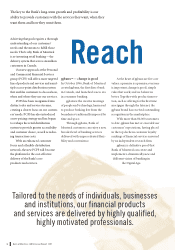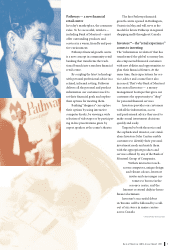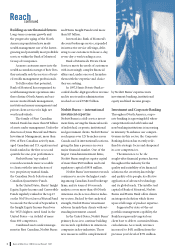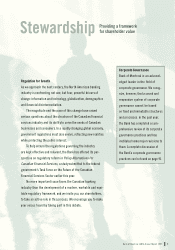Bank of Montreal 1997 Annual Report Download - page 18
Download and view the complete annual report
Please find page 18 of the 1997 Bank of Montreal annual report below. You can navigate through the pages in the report by either clicking on the pages listed below, or by using the keyword search tool below to find specific information within the annual report.
Bank of Montreal 180th Annual Report 199716
Along with the strengthening in the Tier 1
ratio and the issuance of $700 million in subor-
dinated debt, our Total Capital Ratio (defined as
the ratio of total capital to risk-weighted assets)
increased from 9.11% in 1996 to 9.66%.
(Details: Page 48.)
Liquidity Management: Large Base of Deposits
The Bank’s total liquid assets increased by
$13.2 billion or 21.8% in 1997, and our liquidity
ratio the ratio of cash, securities and deposits
we have with other banks to total assets dipped
slightly from 35.8% in 1996 to 35.6%. Growth
in most loan categories accounted for the increase
in total assets. (Details: Page 50.)
Short- and Long-term Gain
In summary, the most striking feature of 1997 for
the Bank of Montreal Group of Companies is not
so much a new record for earnings, or the 17.1%
achieved in our return on shareholders’ equity.
The most striking feature, rather, is that we were
able to produce these and other good numbers,
as discussed in more detail over the following
pages, at the same time that we were investing very
heavily and very strategically in the future.
While we were busy increasing shareholder
value in 1997, in other words, we were also busy
ensuring that shareholder value will continue
to increase in the years ahead. And proving to
ourselves, the marketplace and the world that
if we think and plan ahead, our shareholders
really can have it both ways.
Asset Quality Management: A Well
Diversified Portfolio
In order to maintain an appropriate risk-return
relationship in 1997, we continued our strategic
commitment to ensure a well diversified asset
portfolio regardless of the economic environment.
Net credit losses on specific accounts were
$75 million, an historically low level that reflects
the continuing strength of our credit risk man-
agement practices. This performance results from
considerable success in recovering previously
recorded provisions, which had been established
on a conservative basis. An additional $200 mil-
lion was charged to current earnings to increase
our general provisions, which brought the total
provision for credit losses to $275 million, up
$50 million from 1996.
Our commitment to prudent asset manage-
ment policies was further reflected by the fact that
$100 million of allowance for credit losses for
Harris Regional Banking was transferred to the gen
-
eral allowance. As a result, the general allowance
stands at $775 million, the maximum allowable
by the Office of the Superintendent of Financial
Institutions for inclusion in our Tier 2 capital.
At the same time, due to the improvement
in asset quality coupled with generally favourable
economic conditions, gross impaired loans de-
clined for the fourth straight year, to $787 million
in 1997 from $1,397 million in 1996, the previous
record-holding year. As a result, for the first year
on record the allowance for credit losses exceeds
the gross amount of impaired loans.
(Details: Page 45.)
Capital Management: Initiatives Accomplished
Driven by an 18.7% increase in the Bank’s Tier 1
capital and a 17.0% increase in risk-weighted
assets, we increased our Tier 1 Ratio from 6.71%
in 1996 to 6.80% in 1997. The increase in Tier 1
capital was due largely to retained earnings
growth plus the issuance of $400 million of
preferred shares in the second quarter.
The increase in risk-weighted assets was
a result of strong business volume growth
partly offset by initiatives aimed at moderating
growth to a level more supportable by inter-
nally generated capital. These initiatives included
the securitization of $2 billion in credit card
receivables and the purchase of portfolio insurance
on $8 billion worth of conventional residential
mortgages in Canada.
F. Anthony Comper
President and
Chief Operating Officer
























